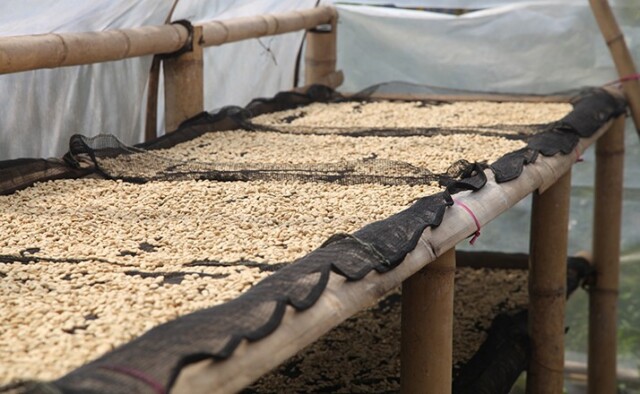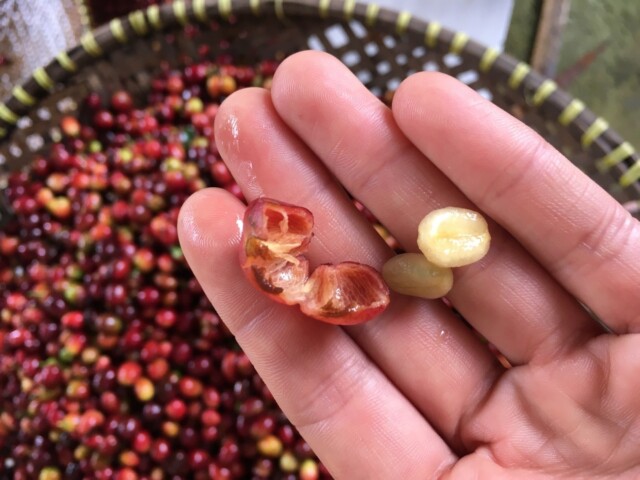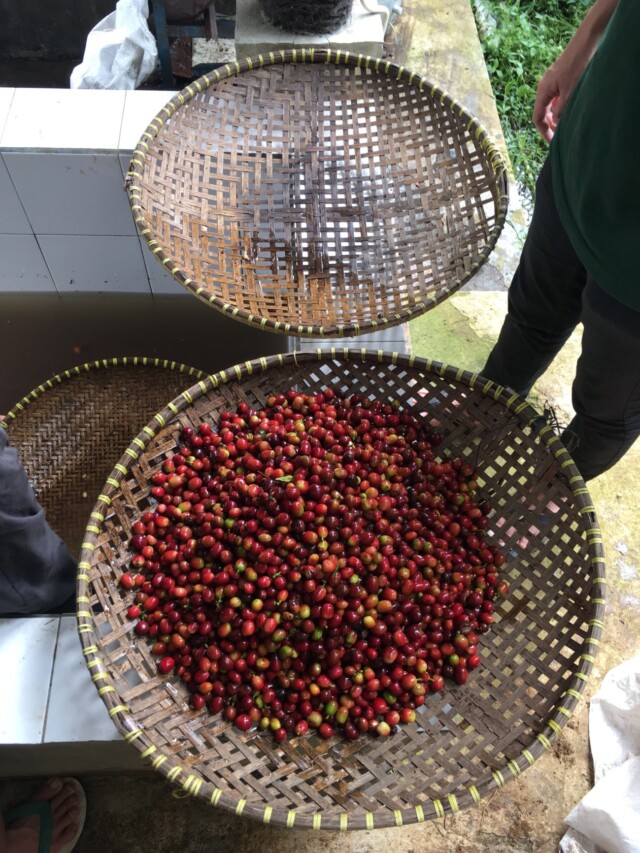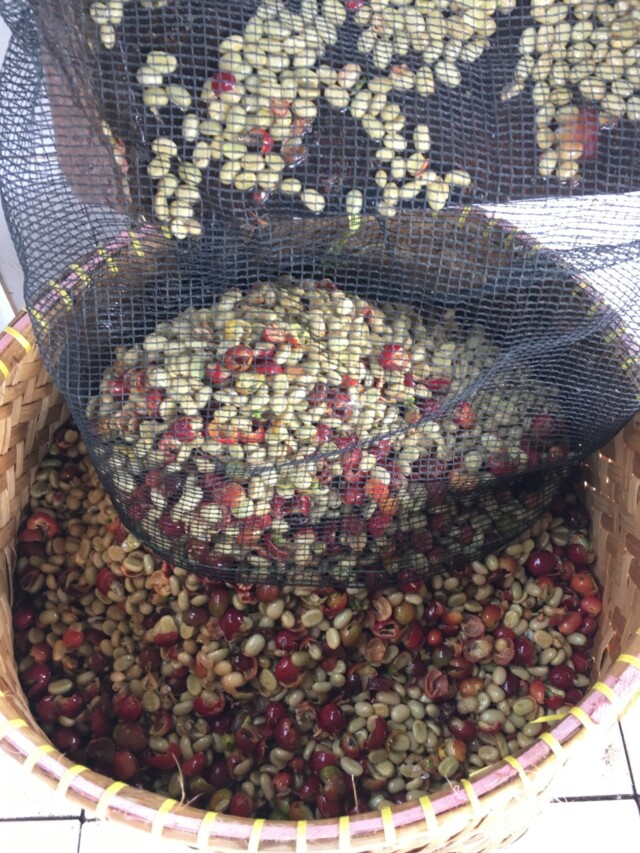Indonesia Sunda Radiophare
Cooperative
Yadi and Eko dreamed of producing quality coffees. Their meeting with Oceane, an agronomist and delegate of the french embassy in Jakarta, was providential. While she consulted with CIRAD’s experts on technical aspects in improving the processing method, they created Klasik Beans with a small number of producers.
Working side by side, all three were improving and attracting customers. Oceane left her job at the embassy to become a professor and researcher at the University of Montpellier returning every summer to Indonesia.
After a difficult beginning the reward came with customers from outside Indonesia, specifically from the US and Australia. Today its coffee is also exported to several customers in Europe.
In addition to their 5 wet mills in central Java, they have 2 in Bali, and they buy parchment from Flores and Sulawesi (Celebes), where they invest in greenhouses with sliding plastic doors and raised african beds of 2-3 levels for a good drying.
This batch of Sunda Radiophare was exported with a water activity of 0.60 which ensures a stable coffee with the pass of time and that will not taste like coffee bags or old crop in 2-3 months as they usually happen with the wet hulled process done with little care. With this threshing, it is also possible to maintain this “characteristic” cup of a wet hulled and the typical profile that can usually be associated with an Indonesian coffee, without defect and with good complexity.
The Sundanese (Sundanese: Urang Sunda) are a native ethnic group of the western part of the Indonesian island of Java. They are about 40 million, and are the second most populous ethnic group of all ethnic nations. The name Sunda derives from the Sanskrit prefix su- which means “goodness” or “possess good quality”. The term Sunda also means bright, light, purity, cleanliness and white.
Radiophare was the name of the local radio station built in 1917 by the Dutch during the colony. They used it to call home and also functioned as a social club near their summer houses in the cool Puntang Mountains. In 1945, when Indonesia finally gained independence from the Netherlands, the Sundanese people destroyed the station fearing the return of the Dutch. Today all that remains of it are its ruins taken by the tropical vegetation and the locals don’t even think of rebuilding the station since it symbolizes the colony and the days of domination on the sovereignty of the sundaneses.
Process Method | Giling Basah
Milling in Indonesia, and more specifically in the islands of Sumatra and Sulawesi, is unique and deeply rooted in local culture. This, let’s say variation, gives the coffees of these islands a distinctive character by which they are known worldwide. A risky process due to the potential to generate defective aromas of wet or mouldy soil but in the best batches offers unique profiles with high density, low acidity and aromas not found in other methods.
After harvest, the cherries are manually pulped and the beans loaded with their mucilage still very moist are fermented overnight (10 to 12 hrs) in plastic bags or wicker baskets and then washed by hand with clean water. Then they are dried to moisture levels of 30% to 40% and here is the variation, at this point the parchment is removed and the unprotected beans are dried in the sun until finally they reach between 12% – 13 % moisture content. For the best lots the beans are classified by size and weight as well as passing through a manual selection.
Origin
Java Occidental fue la primera plantación de café de la VOC (Compañía Neerlandesa de las Indias Orientales). Los holandeses comenzaron a cultivar y exportar cafés en Java en el siglo XVII. A finales de 1880 la roya mató gran parte de las plantaciones en el área de Sukabumi antes de extenderse a Java Central y partes de Java Oriental. Los holandeses respondieron reemplazando parte del Arábica primero con Libérica (una especie resistente, pero de sabor desagradable) y más tarde con Robusta.
Actualmente, las antiguas plantaciones de la era colonial de Java proporcionan sólo una fracción del café cultivado en la isla; producen principalmente la especie bien valorada Arábica. Su producción se centra en la meseta de Ijen, en el extremo oriental de Java, a una altitud de más de 1.400 metros. El café se cultiva principalmente en grandes propiedades construidas por los holandeses en el siglo XVIII. Las cinco fincas más grandes son Blawan, Djampit, Pancur, Kayumas y Tugosari, y cubren más de 4.000 hectáreas.
Este café es apreciado como un componente en el tradicional blend “Mocca Java”, que marida cafés de Yemen y Java. Algunos distritos envejecen una porción de su café hasta cinco años, normalmente en sacos grandes de estopa, que se ventilan, se desempolvan y se voltean regularmente. A medida que envejecen, los granos cambian de verde a marrón claro, y sus sabores ganan fuerza mientras pierden acidez. Los cafés envejecidos pueden mostrar sabores que van desde el cedro a las especias como la canela o el clavo, y a menudo desarrollan un cuerpo denso, casi meloso. Estos cafés envejecidos son llamados Old Government, Old Brown u Old Java.
Indonesia es de los países más ricos en cuanto a variedad de beneficio pues tienen:
a) Semi lavado: despulpado y fermentado en seco (como un Pulped Natural de Brasil)
b) Lavado: despulpado y fermentado húmedo (como un Fully Washed de África).
c) Natural: cereza entera secada al sol (común en Etiopía, Panamá y Brasil).
d) Red Honey: secado con el mucílago (como en Costa Rica).
Y dos tipos de trillado del pergamino:
a) A 12-13% de humedad: que le llaman Dry Hulled, que es el trillado clásico como en cualquier parte del mundo.
b) A 30-40% humedad: clásico Wet Hulled Indonesio, se originó en Sumatra por las condiciones climatológicas. El secado del los granos sigue sin su pergamino hasta alcanzar los 12% de humedad.
11,50 € – 46 €
Free shipping from €40 purchase



